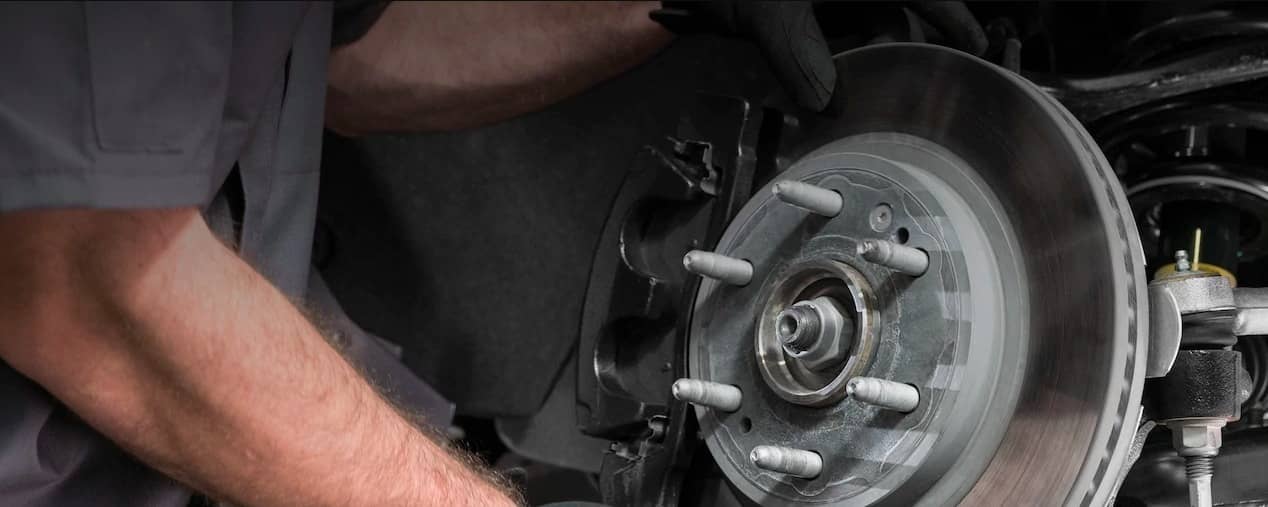How Much Is It To Fix Squeaky Brakes

Fixing squeaky brakes doesn't always require a trip to your local service center. Sometimes, all you need is a small, simple adjustment to fix the problems which cause brakes to squeak. Read our guide below to find out why your brakes are squealing and how to fix it.
Service Contact Us
What is Brake Squeal?
Simply put, brake squeal is vibration. When you press on the brake, the calipers squeeze the brake pads against the brake rotors. This causes friction and slows the car down. Since the brake pads are less than a millimeter from the rotors, there's little clearance and a lot of pressure and friction. This means that when they're under additional pressure, they may make a noise.
This can happen with brand new brakes or brakes you've been using a while, and the sound doesn't necessarily signal that you're in need of replacement. Sometimes, brake noises are just annoying, but other times, they can also alert us to more serious problems.
Let's check out the three most common problems that cause brake noises.
Why the Noise?
- If you notice that your brakes make noise only sometimes, it might be due to moisture, dust, or small rocks and debris stuck in between the pad and rotor surface. If you hear a scraping sound, check to make sure you didn't pick up a rock or debris from the road. Often, you'll just have to clean the rotor surface and brake pad.
- A squealing/squeaking noise is caused by rust formation, usually due to water on the rotors. If moisture collects on the rotors surface, a thin layer of rust is formed. If you park your car outdoors, you may find that your brakes squeak when you drive the car in the morning. As you begin driving off, the rust gets scraped off by the brake pads, and this produces a high-pitched squeal. Once that rust is off, the noise should subside.
- The most common cause for brake noise is thinning pads. If you hear a grind or loud shrill, you've likely worn your pads down. Because the brake pads are worn down, the pads and rotors are now metal to metal. At this point, it is imperative to replace them. If you don't, the pads can grind the rotors down and/or cause them to warp or break. It's best to replace the pads as soon as possible to prevent further damage to the rotors.
- Lastly, the brake pads themselves may be the cause for squeaky brakes. Cheap brake pads often contain high metal content. Large metal flakes are embedded in the brake material, and when the metal drags across the rotors, it will squeak. This noise is more annoying than anything and not a sign of a failing brake system. However, the best way to avoid the squeak is to choose quality, less aggressive brake pads that have been designed for your vehicle.
Step-by-step Guide to Quieter Brakes
The simplest solution to quieting your brakes is to change your pads. While there are a million pad suppliers out there, we recommend buying OEM parts from your local dealer or a trusted supplier. Research your particular make and model or check your owner's manual to find the best pads for your vehicle. Follow the steps below to learn how to change your brake pads.
- Loosen the lug nuts on the wheels with a tire iron. You'll need to loosen the nuts before you lift the car.
- Using a jack, raise the vehicle and secure it on jack stands.
- Now, you can safely finish unscrewing the lug nuts and remove the wheel.
- Remove the caliper assembly. You'll need a socket wrench to remove the bolts on the back of the caliper. The assembly will still be attached to the brake line. Do not let the caliper hang. Set it on a rotor or use a wire to hang it in the wheel well.
- Remove the brake pads from the rotor.
- With the pads and caliper removed, inspect the rotor for cracks, warps, or grooves. If the rotor has damage, remove and replace the rotor. If the rotor doesn't need to be replaced, continue.
- Use brake cleaner or soap and water to clean the rotors, then wipe it down with a clean towel. You can also use a metal wire brush to clean the caliper where the brake pads make contact.
- Lubricate any contact points between the brake pad and brake caliper with anti-seize. Lubricate right where the brake pad and guide meets on the caliper bracket. Also, lubricate the brake hardware. This helps the brake pad slide back and forth as the brakes are used. Lastly, add a thin layer of anti-seize on the back of the brake pad to prevent squeaks.
- Perform steps 5-1 in reverse to reinstall the new brake pads. And you're done!
Have Your Brakes Serviced at Elgin CDJR
While changing your brake pads is an easy process, if you'd prefer to leave brake replacements to the professionals, reach out to us at Elgin Chrysler Dodge Jeep Ram. You can schedule a service appointment online or call our Chicago area dealership directly. Our specially trained technicians will have your brakes functioning again in no time! We offer service specials, expert assistance, and more DIY car maintenance guides - like how to change your engine air filter and how to maintain tire condition - so feel free to contact us today.
How Much Is It To Fix Squeaky Brakes
Source: https://www.elgincdjr.com/how-to-fix-squeaky-brakes.htm
Posted by: calhoundigh1971.blogspot.com

0 Response to "How Much Is It To Fix Squeaky Brakes"
Post a Comment